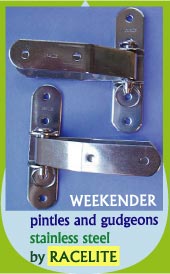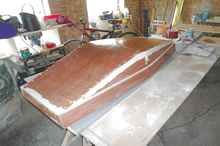
 Custom Search
|
|
| sails |
| plans |
| epoxy |
| rope/line |
| hardware |
| canoe/Kayak |
| sailmaking |
| materials |
| models |
| media |
| tools |
| gear |
 |
 |
| join |
| home |
| indexes |
| classifieds |
| calendar |
| archives |
| about |
| links |
| Join Duckworks Get free newsletter Comment on articles CLICK HERE |
|
|
| English Mouse Boat |
by Adrian and Molly Ratcliffe
- Harrowgate, North Yorkshire - England |
Whilst working at Harrogate College (England) as a technician/tutor in the joinery workshops, I asked a student what he would like to make. "A boat", he said. I dismissed the idea as we are 80 miles inland from the coast. Recently, I ran out of ideas to keep some students busy and the idea of making a boat surfaced again. After researching boats on the internet, the one sheet skiff seemed appropriate so one morning I cut the shapes out and had a crack at making one. This is when it all started to happen. By lunchtime I had a crowd of boat building experts around me. "It won't float the sides are too shallow". By teatime I had been nicknamed Davy Jones and a betting ring had been formed. On my arrival home that night I proudly announced to my wife that I was building a boat. "No you're not". With hindsight this was my first boatbuilding mistake. What follows now is after 200 hours research on the internet and a couple of books on boatbuilding. The second book threw most light on the subject and was worth the money (Building Classic Small Craft by John Gardner). Barriers to Building a BoatI bet that most home boat builders never get past the garage doors with a homemade boat. The reasons for this are many; you need water near enough and a trailer for a start. In England we have plenty of canals built in the industrial revolution. The British waterways just love half finished boats with kids in flying around in and amongst the barges. You need a licence and public liability insurance for a start, even if it sinks as soon as hits the wet stuff. So I thought a mouse boat would be the way forward, a mouse boat that would fit inside a car rather than on the roof rack or trailer, in this instance my car. This little move started the ball rolling. I was now under the spotlight and starting to feel the pressure. The next project will be built under the cover of darkness and tested wearing a balaclava. My only reservation from start to finish was: please just float even if it's only for a few minutes. I whacked it together one day whilst in college, threw it in the car and set off home. I pasted a pub on my way back and could hear the laughter from the people sat by the road having a beer. It must have been a novelty for them to see a boat in a Smart car, who says you can't anyway.
At HomeThe wife was at work, so for all her support I left her a present on the kitchen table and went out for several pints. TerminologyThis being my first boat or "will it float" project I took the decision to use what I had in the garage and some advice from an old joiner (my Dad) who when asked about boats said one thing "cascamite it". The use of chine logs, fibreglass and purchasing expensive equipment was now out of the question, as my wife has the purse strings and wasn't tickled pink by the idea. It won't look any cuter on the sea bed after blowing the budget on marine paints either. I used plenty of glue loads of screws and my head, some 2 pack waterproof filler and made the fatal mistake of using household gloss, which is still drying now nearly 2 weeks after the initial painting. Dimensions: 54 inches long by 24 inches wide. After being relegated to the garage, I got the boat on the operating table and gave it the once over with cascamite. This took 4 days to cure. I suppose you can use PU glue or any foaming glue but foaming glue pushes joints apart as it foams, not something I fancied happening in a boat. Having found that acrylic paints grab to the cascamite I caulked the boat off with exterior decorators caulk that was waterproof. To be honest I never felt confident about my own ability and always had nagging doubts. This chain of thought will inevitably lead to those with a weaker mind to not pursue the dream. Please do though and prove the doubters wrong. KidsThe mouse boat was built as a project for my daughter to paint under the pretence that I didn't actually want a boat myself and providing cover for when or if it went down. My daughter picked the paint and named the boat "Tommy Ten" after the horse she rides. This project has cost around £20 to date its ideal for kids to knock together and they spend more time painting it than actually using it. ConsiderationsI started to wonder where I could actually float my boat if you know what I mean. We have lakes and reservoirs nearby, I approached sailing clubs who not so politely declined, and the local tarns wanted public liability insurance. This is England and unless you have a large pond in your back yard you may find your boat used for plants or converted into a small bookcase. Do what I did, drop it in the canal and if it goes down leave it there. DesignI kept the design as simple as possible and to be honest I wouldn't bother bevelling (sloping the sides) as it is easier for your first boat keep everything square. One improvement would be a foot support in the bottom of the boat attached to the 2x1 at either side. The launchAfter a lot of soul searching I loaded the boat up one night after tea said a few prayers and drove down the road half a mile to the canal and popped it in. My daughter was as surprised as me - 20 minutes and still bobbing. Oars added my daughter had never been in a boat by herself, let alone a rowing boat. One hour later and still afloat. Two hours later if it was going to go down it would have done it by now. The boat was bone dry. ConclusionWe have been out now several times and I am constantly asked questions by passersby surrounding this little boat. Many are surprised to see a wooden boat and are interested to know more. The barge owners all stop and talk; every child that goes past it either wants one or wants a go. I have been inspired by all the contributors to Duckworks and with all the people who contribute to the site. Anybody wanting the complete instructions is more than welcome to contact me. |
 |









